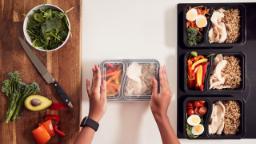
Whether you want to save money by taking your lunch to the office or you just never have enough time during the week to cook dinner, meal prepping can save time, help you shop smarter, make your money go further and help you eat healthier.
Ask any dedicated meal prepper and they’ll tell you the most important part of meal prep is the planning. Allyson Spungin, a certified personal trainer, nutrition coach and nationally qualified NPC competitor, says, “Have a plan! Map out your meals and snack ideas before grocery shopping or ordering online.” Jessica Woo, who calls herself the Bento Box Queen, agrees. “Routine is everything,” she says.
Part of having that plan and creating a routine that works for you is investing in a set of meal prep containers for food storage that works for your needs. We spoke to meal prep experts about their favorite meal prep containers, along with other tips and tricks to turn you into a meal prep pro.
Glass containers like these are helpful if you prefer to quickly see what’s inside. However, these aren’t partitioned, so they’re best suited for things like pasta or casseroles that are served individually. When storing prepared foods, Woo says you should “keep your warm items and cold items in separate containers so it’s easier to reheat your warm items.”
Experts agree on the importance of planning, but there are different approaches to meal prep, and they stress that it isn’t a one-size-fits-all proposition. “I encourage people to think of meal prep as an act of self-care versus a means of sticking to rigid food rules,” Cara Harbstreet, a registered dietitian who focuses on intuitive eating, says. “One helpful trick I learned was to think of my meals as an assembly line rather than individual, fully prepared meals,” Harbstreet says. The assembly line approach provides more options and flexibility.
“Glass Mason jars are my favorite fridge food storage containers,” says Kristen Hong, who documents her beautifully organized and meal-prepped fridges on Instagram. “The clear glass helps you easily see what you have available in the fridge, and the jars are stackable so you maximize vertical space.” She uses the 16-ounce size for storing homemade dips and sauces, fresh herbs and chopped produce for use in what she calls her “in-fridge salad bar.”
Another thing about Mason jars Hong loves is that they come in a variety of sizes, so you can amass a collection that works for a lot of different food storage needs. She uses 32-ounce Mason jars for storing homemade soups and prepared salads, as well as for pantry storage. “This size Mason jar also works very well for dry pantry storage for dried beans and grains,” Hong says.
Collapsible meal prep containers are helpful for when you finish your food but don’t want the bowl to take up too much space on the way home or in your cabinets. These leakproof containers are freezer-safe and a good choice for people with limited space.
Produce that’s gone off in the refrigerator is a frustrating part of meal prep; these produce storage containers help to keep expensive fruits and veggies fresher for longer.
Salads can be a pain to meal prep, since you typically don’t want to combine all the ingredients until you’re ready to eat. Try out this leak-proof round container for your next meal prep, which even features a plate and dressing cup for a takeout-worthy salad.
One problem with salads is that if you dress them too long before eating, they’ll turn into a sad, soggy mess. These leakproof, BPA-free plastic condiment containers are perfect for storing salad dressings and sauces separate from your meal until you’re ready to eat.
Spungin offers one last piece of advice for those who are new to meal prepping: “Don’t. Get. Hungry!” She stresses the importance of keeping nutritious snacks on hand, which can help to prevent poor food choices made out of hunger. Buying snacks in bulk and storing individual portions in these eco-friendly Stasher silicone storage bags will save money and cut down on packaging waste.
These three-compartment plastic containers are great for someone who is getting into meal prepping because you can portion out your meals, microwave them, then throw the container in the dishwasher once you’re done.
A stainless steel bento box like this one is good for your wallet and the environment. The eco-friendly food storage container comes with three removable compartments that you can swap around to plan your meal exactly how you want it.
We have our eyes on this BPA-free plastic set from Bentgo, not only because the containers are adorable, but they also include an optional divider to create a fourth compartment. Customization is key for meal prep containers that will last you from week to week.
Having a variety of different-sized containers is always convenient. Opt for this set of 42 from Rubbermaid, made with lids that snap onto the base so that you won’t lose them.
Keeping meal-size portions in the freezer can also help to keep boredom at bay. Kevin Curry, the founder of Fit Men Cook, says, “The No. 1 tip I have for people who are new to meal prepping is that it does NOT have to be boring. Boring recipes make it much more challenging to stick to a meal prepping routine.”
These storage containers feature built-in lid vents to avoid excessive splatter in the microwave while warming up your food.
Cooking in bulk and using these BPA-free, leak-proof meal prep containers to store food will allow you to assemble meals throughout the week with ease. “I pick a couple of protein sources like chicken and shrimp, carb sources like rice and sweet potatoes [and] have fats on hand like olive oil and avocados to combine for meals,” Spungin says.
These versatile freezer containers have got it all: They’re microwave-, dishwasher- and freezer-safe, and the leak-proof, BPA-free snap-on lids have built-in vents that allow you to microwave food with the lid on to prevent messy splatters.
These leak-proof and freezer-safe round glass containers are perfect for storing homemade soups and stews in the freezer. This line of BPA-free food storage containers comes in sizes from 1 cup to 8 cups, and the lids are interchangeable, so you can build a set that works for your exact needs.
This planning pad makes meal prep simple. Featuring a tear-off shopping list and space for weekly meal planning, this pad sticks right onto your fridge to keep you on track.
Spungin designates one day for cooking and, to make it less stressful, suggests scheduling meal prep for a day when you don’t have several other things to do. “Not a leftovers person? Pick two prep days,” she says. “For instance, Sunday for the first part of the week and Wednesday for the second half.”
Woo builds her meal prep into her existing schedule. “I like to meal prep when I am already cooking dinner or lunch,” she says. “Cook as if you are cooking for seven people and you can freeze individual meals,” which can be defrosted for a quick lunch or dinner.
Don’t let anyone tell you that meal prep can’t be delicious. Grab this book by author Chungah Rhee for some inspiration for your upcoming meals from breakfast to comfort foods.
The idea of cooking all your meals at once can be pretty intimidating. Author Cassy Joy Garcia wants to help out with that in this book that offers guidance on how to make batch cooking simple.
All of the experts stressed the importance of keeping your kitchen stocked with the essentials of successful cooking. Spungin suggests investing in basic cookware, storage containers, measuring tools, spices and cooking oils. “That way all you need is the food,” Curry adds. “And don’t forget a quality cutting board and chef’s knife!”
Check out our picks for the best kitchen knife sets and best cutting board if you’re in the market for new supplies.
Woo encourages new meal preppers to start small. When you’re just starting, she says it’s a good idea to plan one a week at a time “so you don’t overwhelm yourself.” Likewise, she says that new cooks should stick with easy recipes. “Get comfortable doing the basics,” she says. “Start with easy recipes you’re comfortable cooking, and it will get easier with time.”
Timing can be a struggle for those who are newer to cooking or who aren’t used to prepping many items at once, but a kitchen timer can solve both problems.
The experts we spoke with all love small appliances to make meal prep easier on them. One way Woo makes things easy for herself is using a food chopper to cut up a lot of vegetables at once, which can be cooked or stored raw.
Curry also relies on small appliances. “I couldn’t live without my Instant Pot Duo Plus and my Breville Smart Oven.” Spungin, too, swears by the Instant Pot as well as her air fryer, both of which she says are major time-savers. “The Instant Pot is great for cooking foods in bulk like soup, chili, stew, etc. and you can slow cook while tackling other parts of your prep.”
An air fryer might also be a good option if you’re looking to make your favorite foods without the excess oils or calories, as opposed to other cooking methods like deep-frying.
Curry stresses the importance of learning to multitask in the kitchen. “When I’m meal prepping, I’ve got three, four or sometimes five things on the go. I’m sweating. I’m hopping around the kitchen like I’m Remy from ‘Ratatouille.’” Prepping in this way, he says, not only saves him a lot of time, but it also makes meal prep a more engaging and enjoyable activity. Turning on music or a favorite podcast while you prep can help to make the time go faster and turn it into fun. Read our review of the Echo Dot 5th Gen here.
Curry has another suggestion for combating meal prep boredom and saving some time: “Don’t be afraid of leftovers. Get creative with them! One of my favorite things is experimenting with a batch of leftover rice to see what kind of quick, cheap and tasty dish I can put together.” To prevent food waste, Harbstreet says to label your prepped meals clearly so you know how long you have to enjoy them.

























































